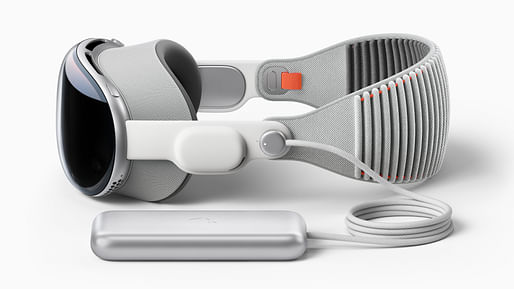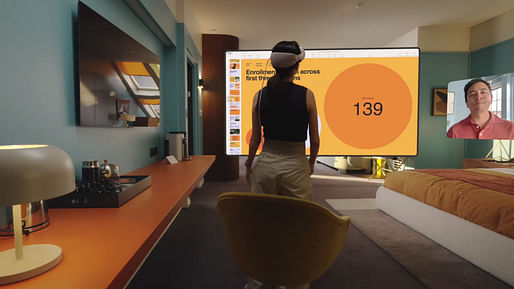
Apple has publicly unveiled the Apple Vision Pro, which the company describes as a “revolutionary spatial computer that seamlessly blends digital content with the physical world.” The device is set to be available for purchase in the U.S. early in 2024, with a starting price of $3,499.

A series of demonstration videos released by Apple show users navigating through a three-dimensional interface using eyes, hands, and voice, with the Vision Pro’s “infinite canvas of apps” populating their surrounding environment. The headset device is powered by visionOS, which Apple describes as “the world’s first spatial operating system,” allowing users to “interact with digital content in a way that feels like it is physically present in their space.”
Product specs detailed by Apple include a high-resolution display system containing 23 million pixels across two displays, encased within an aluminum alloy frame. The device integrates 12 cameras, including Apple’s first 3D camera, five sensors, and six microphones to take in its surroundings, and can run on two hours of battery life, or all-day use when plugged in.
Announcing the product, Apple CEO Tim Cook hailed the Vision Pro as the beginning of a new era for computing. “Just as the Mac introduced us to personal computing, and iPhone introduced us to mobile computing, Apple Vision Pro introduces us to spatial computing,” Cook said. “Built upon decades of Apple innovation, Vision Pro is years ahead and unlike anything created before — with a revolutionary new input system and thousands of groundbreaking innovations. It unlocks incredible experiences for our users and exciting new opportunities for our developers.”
Video credit: Apple
Apple’s demonstration of how Vision Pro can be used for work was itself set in a design office. Describing the environment as a “canvas for apps,” the presentation showed a designer immersed in an AR environment within their studio, switching between a project presentation and an online article about the project. In the scene’s most impressive moment, the designer received an iMessage containing the text file for a canopy design and pulled a 3D model of the canopy out onto their workbench for closer inspection.

Architects may also see opportunities in the device’s ability to immerse them and clients in designed environments. “With Environments, a user’s world can grow beyond the dimensions of a physical room with dynamic, beautiful landscapes that can help them focus or reduce clutter in busy spaces,” the company explains.
More details on architectural applications and consequences of the Vision Pro, and of spatial computing in general, are likely to emerge in the coming months.
This article is part of the Archinect In-Depth: Artificial Intelligence series.
5 Comments
It costs $3,500. Other similar headsets cost around $300.
I need to try it and see whether it makes me as nauseous as the other 300$ ones I still will not get any of them lol...
Stay at home. Stay on our products. Order your bag of food.
This is where lack of architecture and design values in culture really hurts [big tech]. They are missing the entire point of AR, which is NOT a FacePhone
But now you get to cosplay Tony Stark
Block this user
Are you sure you want to block this user and hide all related comments throughout the site?
Archinect
This is your first comment on Archinect. Your comment will be visible once approved.